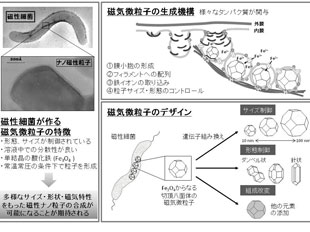磁性細菌の磁気微粒子生成機構を利用したナノ磁性材料の創出
メンバー: 新垣篤史
分野: 材料工学、プロセス・化学工学、ゲノム科学
所属: 工学研究院
キーワード: 磁気微粒子、結晶形態制御、磁性細菌、遺伝子工学
ウェブサイト:
研究概要

当研究グループでは、磁気微粒子を合成するユニークな微生物に注目して研究を行っています。この微生物は磁性細菌と呼ばれ、細胞の中に粒径が数十~100 nmほどの酸化鉄磁気微粒子を合成します。粒子の形態とサイズは細菌種毎に制御されており、中には人工的に合成の困難な形態の磁気微粒子を合成する細菌も存在します。したがって、この磁気微粒子生成機構を解明し応用することで、常温・常圧の穏やかな条件下で形態の制御された有用な材料を創製できる可能性があります。私達は、磁性細菌の粒子合成機構の解明に取り組み、磁性細菌で生成される粒子の自在な制御を目指しています。具体的には、細菌のゲノム情報に基づいて、分子レベルでの合成機構の解明に取り組んでおります。また、遺伝子組換えによって、細胞内に合成される磁気微粒子の形態を制御することに成功しています。鉄以外の微量の金属を添加することで磁気微粒子の組成を改変し、磁気特性を向上することにも成功しています。
主要論文・参考事項
Arakaki, A., Shibata, K., Mogi, T., Hosokawa, M., Hatakeyama, K., Gomyo, H., Taguchi, T., Wake, H., Tanaami, T., Matsunaga, T., Tanaka, T. “Efficient DNA Release from PAMAM Dendrimer-Modified Superparamagnetic Nanoparticles for DNA Recovery”, Polymer J., 44. 672-677 (2012).
Tanaka, M., Mazuyama, E., Arakaki, A., Matsunaga, T. “Mms6 Protein Regulates Crystal Morphology during Nano-Sized Magnetite Biomineralization”, J. Biol. Chem., 286, 6386-6392 (2011).
Tanaka, M., Arakaki, A., Matsunaga, T. “Identification and Functional Characterization of Liposome Tubulation Protein from Magnetotactic Bacteria”, Mol. Microbiol., 76, 480-488 (2010).
Arakaki, A., Masuda, F., Amemiya, Y., Tanaka, T., Matsunaga, T. “Control of the Morphology and Size of Magnetite Particles with Peptides Mimicking the Mms6 Protein from Magnetotactic Bacteria”, J. Colloid Int. Sci., 343, 65-70 (2010).
お問い合わせ先
東京農工大学・先端産学連携研究推進センター
urac[at]ml.tuat.ac.jp([at]を@に変換してください)
Development of Nanosized Magnetic Material Using Magnetotactic Bacteria
Research members: Dr. Atsushi Arakaki
Research fields: Material engineering, Process/Chemical engineering, Genome science
Departments: Institute of Engineering
Keywords: 磁気微粒子,結晶形態制御,磁性細菌,遺伝子工学
Web site:
Summary

Magnetotactic bacteria synthesize magnetic iron-oxide nano-particles under ambient environmental conditions. Various crystal morphologies and sizes have been observed that are species or strain dependent, indicating that there is a high degree of biological control. We identified a group of proteins, which involved in the morphological control of the magnetic particles. To use the functional domain of the proteins, we succeeded to control morphologies of iron oxide particles in octahedron and cubo-octahedoron in in vitro experiment. In addition, we showed that the gene deletion mutant strains synthesized elongated particles with high-index uncommon crystal faces, which are unable to synthesize by chemical synthetic method. This is the first example of a protein being involved in the regulation of a nano-sized crystallographic structure in in vivo biomineralization. Because the size and morphology of magnetic nano-particles are strongly influence to their magnetic properties, control of these factors is an important issue with regard to using them for advanced biological and medical uses as well as the other industrial applications. Further elucidation of the mechanism will allow us to design and control size and morphology of magnetic nano-materials in bacterial cells.
Reference articles and patents
Arakaki, A., Shibata, K., Mogi, T., Hosokawa, M., Hatakeyama, K., Gomyo, H., Taguchi, T., Wake, H., Tanaami, T., Matsunaga, T., Tanaka, T. “Efficient DNA Release from PAMAM Dendrimer-Modified Superparamagnetic Nanoparticles for DNA Recovery”, Polymer J., 44. 672-677 (2012).
Tanaka, M., Mazuyama, E., Arakaki, A., Matsunaga, T. “Mms6 Protein Regulates Crystal Morphology during Nano-Sized Magnetite Biomineralization”, J. Biol. Chem., 286, 6386-6392 (2011).
Tanaka, M., Arakaki, A., Matsunaga, T. “Identification and Functional Characterization of Liposome Tubulation Protein from Magnetotactic Bacteria”, Mol. Microbiol., 76, 480-488 (2010).
Arakaki, A., Masuda, F., Amemiya, Y., Tanaka, T., Matsunaga, T. “Control of the Morphology and Size of Magnetite Particles with Peptides Mimicking the Mms6 Protein from Magnetotactic Bacteria”, J. Colloid Int. Sci., 343, 65-70 (2010).
Contact
University Research Administration Center(URAC),
Tokyo University of Agriculture andTechnology
urac[at]ml.tuat.ac.jp
(Please replace [at] with @.)

